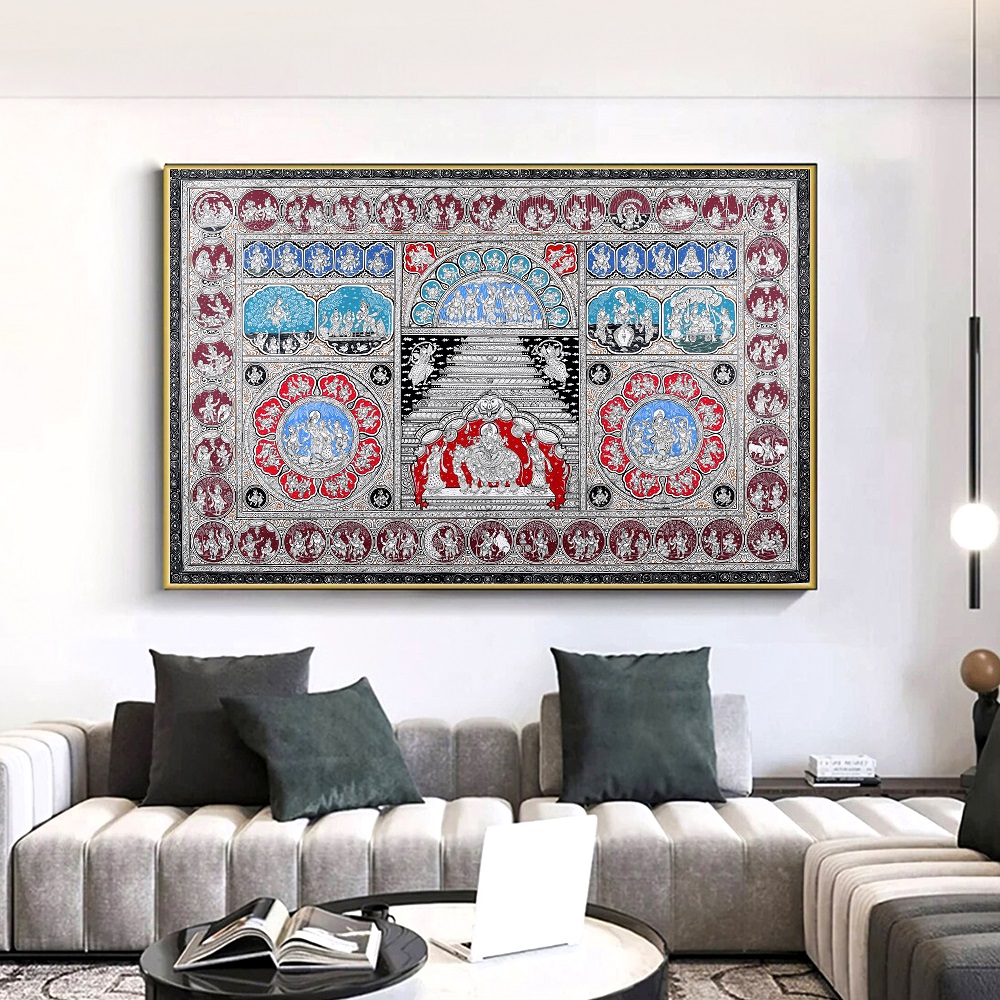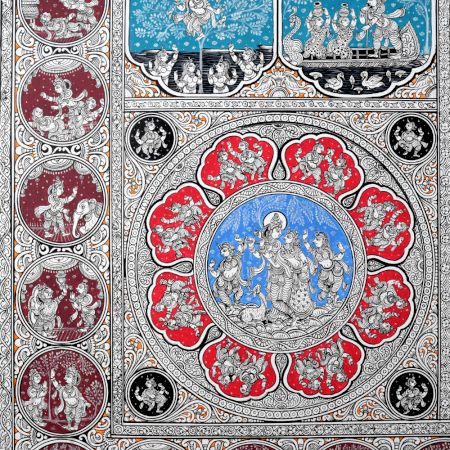This Pattachitra painting showcases scenes from Lord Krishna's Leela (divine play) and intricately depicts the 10 avatars of Lord Vishnu, emphasizing his role in maintaining cosmic balance. The painting highlights Lord Krishna's divine adventures, focusing on his life as a child, his exploits with the Gopis, and his teachings, while also incorporating the 10 incarnations of Vishnu as part of the broader narrative. This Pattachitra painting, made on cloth paper, is a visual masterpiece that highlights the divine essence of Lord Vishnu through his 10 incarnations (avatars). The intricate brushwork and vibrant colors are indicative of the unique style of Odisha's Pattachitra art, which is known for its detailed illustrations and storytelling technique. Each section of the painting represents different phases of Lord Vishnu’s divine purpose on Earth, beginning with his first incarnation, Matsya (the fish), and concluding with the prophecy of Kalki, the future avatar. The central part of the painting is dedicated to Lord Krishna, the most prominent incarnation of Vishnu in Hindu mythology. Lord Krishna, known for his role as a divine cowherd, protector, and guide, is portrayed in various forms. He is shown playing his flute, surrounded by the Gopis, a symbol of his divine love and devotion. This portrayal is a key part of Krishna's Leela, which highlights his playful and affectionate nature, a contrast to the more serious and heroic depictions of other avatars like Rama or Parashurama. The avatars of Vishnu are arranged around Krishna, symbolizing the eternal cycle of creation and destruction. Each avatar, whether Matsya (the fish), Varaha (the boar), or Narasimha (the man-lion), is depicted with symbolic elements that capture the essence of their stories. For example, Matsya is shown as a fish emerging from the waters, signifying the creation of life after a deluge, while Kurma, the tortoise, holds the earth on his back, symbolizing stability. The avatars' forms range from the peaceful Vamana, the dwarf who subdues the demon king Bali, to the fierce Narasimha, who rips apart the demon Hiranyakashipu, illustrating Vishnu’s intervention to protect the righteous. The depiction of the Buddha represents Vishnu's teachings of compassion and enlightenment, while Kalki is symbolized as a future warrior, signaling the restoration of righteousness in a time of chaos. The borders of the painting are richly adorned with fine details of small divine figures, adding further depth to the story being told. These borders contain additional motifs and gods, further enhancing the spiritual theme. Each character and scene are rendered with deep care, reflecting the artist's devotion and skill in bringing these sacred stories to life. The painting is not just a work of art but a visual representation of the deep philosophical and spiritual teachings associated with Lord Vishnu’s avatars. The careful use of color, design, and imagery invites the viewer to delve into the sacred stories, embodying the essence of these divine beings and their importance in Hindu mythology. This Pattachitra painting is a testament to the enduring power of tradition, culture, and faith. The 10 Avatars of Lord Vishnu depicted in the painting are: Matsya (The Fish), Kurma (The Tortoise), Varaha (The Boar), Narasimha (The Man-Lion), Vamana (The Dwarf), Parashurama (The Axe-wielding Sage), Rama (The Prince of Ayodhya), Krishna (The Divine Cowherd), Buddha (The Enlightened One), Kalki (The Future Avatar)
- Pack of one piece
- As it Appears






















